Similar to men, women are also required to offer Salah, but the rules for performing prayers vary for women. This guide will help girls and females learn how to offer salah (for women). Before starting namaz, all of you need to learn namaz by heart and with the rules of Tajweed.
We've put together a step-by-step guide with pictures of performing Salah for girls and sisters who are learning prayers for the first time or for those who want to refresh their knowledge. If you need to learn the differences between men's and women's Salah/Namaz, after reading this, you will be able to understand it.
Let's start with the preconditions of offering Salah or Namaz (prayer) for females and then proceed to the complete method of offering 2 Rakat Salah for women.
Preconditions of Salah or Namaz (Prayer):
- Cleanliness from impurities (on the body, clothes, and place of prayer).
- Performing Ablution (Wudu).
- Facing the right direction of Qiblah.
- Covering the private parts (All of a woman is considered to be a private part except the face and palms)
- Praying at the proper time.
The following is the complete method of performing a 2 Raka’at Salah. Read the “Note” at the end to know how to pray a 3 or 4 Raka’a Salah.
- Stand upright facing the Qibla
- Make the intention “I intend to perform the Fajr prayer (say the name of the Salah), with 2 Rakaat Fardh (say the number of Rakaats of any prayer – Sunnah or Fardh), for the sake of Allah, I am facing the Holy Kaaba.” The intention need not be said out loud. Saying it in the heart is sufficient.
- Raise hands to the shoulders with palms facing the Qibla and say “Allahu Akbar”.
 The hands should be within the cloth sheet. They should not be brought out.
The hands should be within the cloth sheet. They should not be brought out.
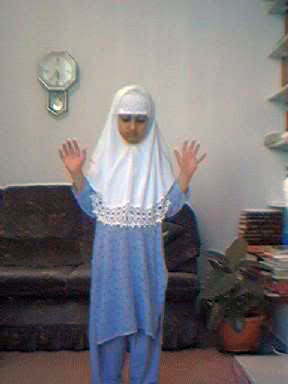
- Do the Qiyam by lowering the hands down and folding them on the chest. This is done by placing the right palm on the back of the left palm.
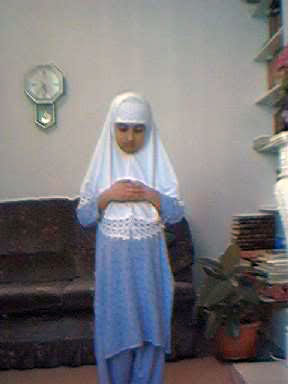
- Read the sanaa:

“Subhanak-Allah humma wabi hamdika watabara-kasmuka wata aala jadduka walaa ilaha ghairuk”
(All Glory be to You O Allah! Praise is to You; Blessed is Your Name and Exalted is Your Majesty; there is none worthy of worship except You) - Read the Ta’awuz:

“Aoozu billahi minash Shaitaanir-rajeem”
(I seek protection with Allah from the cursed Shaitan) - Read the Tasmiyyah:

“Bismillahir rahmanir-raheem”
(In the Name of Allah, Most Kind, Most Merciful) - Recite Surah Fatiha:

“Al-hamdu lillahi rabbil-aalameen, ar-rahma nir-raheem, maaliki yawmiddeen, iyyaaka na’budu wa iyyaaka nastaeen, ihdinas-siraatal mustaqeem, siraatallazeena anamta alaihim, ghairil maghdoobi alahim wa ladhaaleen. Ameen.”
[All praise is due to Allah, the Lord of the Universe, the Most Kind, Most Merciful, Master of the Day of Judgement. You alone we worship and from You alone we ask for help. Guide us on the straight path, the path of those who You have favored, not the path of those who earned Your anger, nor the path of those who went astray. Ameen (So let it be O Allah)]. - Recite any Surah or verses from the Qur’an. For example:

“Qul huwallahu ahad, Allahus-samad, lam yalid, wa lam yoolad, wa lam yakullahu kufuwan ahad”
(Say, He is Allah, The One. Allah is above and all things depend on Allah. He does not beget, nor is He begotten. And there is none like Him). - Say “Allahu Akbar”
 and go into Ruku (bowing). In ruku fingers of both hands should be together and placed on the knees. The arms should be well joined to the sides and the ankles of both feet should be together. A woman should only bow to the extent that their hands reach the knees.
and go into Ruku (bowing). In ruku fingers of both hands should be together and placed on the knees. The arms should be well joined to the sides and the ankles of both feet should be together. A woman should only bow to the extent that their hands reach the knees.
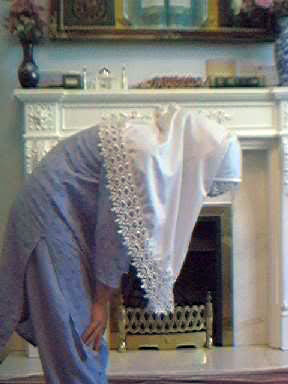
- In Ruku recite the following 3 times:

Subhaana Rabbiyal ‘Azeem
(Glory be to my Lord, The Greatest) - Afterward, stand up in Qawmah position while reciting the Tasbeeh:

Sami Allahu liman hamidah
(Allah listens to him who has praised Him)
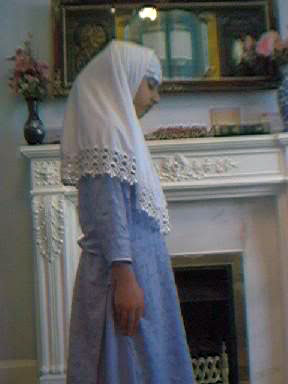
- After Tasbeeh recite Tahmeed:

Allahumma Rabbana Lakal Hamd
(O our Sustainer! All prayer is due to You alone) - Then say “Allahu Akbar”
 and go into Sajdah. First, the knees should touch the ground, thereafter the hands should be placed in line with the ears and the fingers should be close together. Then place the head in between both hands. Both the forehead and the nose should touch the ground. The fingers and toes should face the qibla but the feet should not be upright (Women are not required to place both feet standing on toes). They should be taken out towards the right side. The woman should draw herself closely together and press herself firmly while in Sajdah. The stomach should be joined to both thighs, the arms should be joined to the sides and both arms should be placed on the ground.
and go into Sajdah. First, the knees should touch the ground, thereafter the hands should be placed in line with the ears and the fingers should be close together. Then place the head in between both hands. Both the forehead and the nose should touch the ground. The fingers and toes should face the qibla but the feet should not be upright (Women are not required to place both feet standing on toes). They should be taken out towards the right side. The woman should draw herself closely together and press herself firmly while in Sajdah. The stomach should be joined to both thighs, the arms should be joined to the sides and both arms should be placed on the ground.
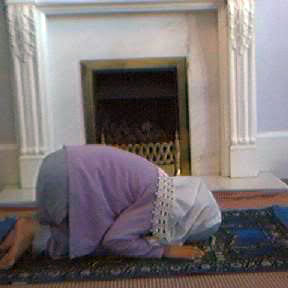
- In Sajdah recite 3 times:

Subhaana Rabbiyal a’ala
(Glory to my Lord Most High) - Afterward, sit upright while saying “Allahu Akbar”.


- Do the Sajdah again while saying “Allahu Akbar”
 and in Sajdah recite “Subhaana Rabbiyal a’ala”
and in Sajdah recite “Subhaana Rabbiyal a’ala”  3 times.
3 times. - Stand up erect while reciting “Allahu Akbar”.
 This position will be Qiyam (same as step #4).
This position will be Qiyam (same as step #4). - Repeat steps #7 to #17. Note: In step #9 recite some other Surah or verses. Then after #17 go to step #20.
- After the second Sajdah, go into Jalsah while saying “Allahu Akbar”.
 The woman should sit on her left buttock and take out both her feet towards the right side. Both her hands should be on the thighs and her fingers joined together.
The woman should sit on her left buttock and take out both her feet towards the right side. Both her hands should be on the thighs and her fingers joined together. - While seated recite Tashahhud:

Attahiyyaatu lillahi wass-salawaatu wath-thayyibaatu, assalamu alaika ayyuhannabiyyu wa rahamtullahi wa barakaatuhu, as-salaamu alainaa wa alaa ibaadilla hiss-saaliheen, ash-hadu al la ilaha illallahu wa ash-hadu anna Muhammadan abduhu wa rasooluh.
(All respect, worship, and all glory are due to Allah alone. Peace be upon you, O Prophet, and the Mercy and Blessings of Allah be upon you. Peace be on us and on those who are the righteous servants of Allah. I testify that there is no one worthy of worship except Allah, and I testify that Muhammad is His Servant and Messenger).
In this when reciting the word “la ilaha”, join the little finger and the ring finger and form a ring with the thumb and middle finger and raise the index finger towards the sky. Lower the index finger when you reach “illallahu”. - Then recite Blessings on the Prophet Muhammad (saw):

Allahumma salli alaa Muhammadin wa alaa aali Muhammadin kamaa sallaita alaa Ibraheema wa alaa aali Ibraheema innaka hameedun majeed
“Allahumma baarik alaa Muhammadin wa alaa aali Muhammadin, kamaa baarakta alaa Ibraheema wa alaa aali Ibraheema innaka hameedun majeed”
(O Allah! Shower Your Blessings on Muhammad and the family of Muhammad just as You showered Your Blessings on Ibraheem and the family of Ibraheem. Certainly, You alone are worthy of praise and are Glorious.
O, Allah! Bless Muhammad and the family of Muhammad just as You Blessed Ibraheem and the family of Ibraheem. Certainly, You alone are worthy of praise and are Glorious). - After this recite the following dua:

Rabbij-alnee muqeemas-salaati wa min zurriyyatee, rabbanaa wata qabbal duaa, rabbanagh-fir-lee wali waali dayya wa lil mu’mineena yawma yaqoomul hisaab
(O my Lord! Make my children and myself regular in Salah. O our Lord! Accept my prayer. O our Lord! Forgive me. Forgive my parents and all other Muslims on the Day of Judgement). - As the last step do Tasleem. Turn your head to the right and say
 “As salamu ‘alaykum wa rahmatullah” (May the Peace and Mercy of Allah be upon you). Then turn your head to the left and say
“As salamu ‘alaykum wa rahmatullah” (May the Peace and Mercy of Allah be upon you). Then turn your head to the left and say  “As salamu ‘alaykum wa rahmatullah” (May the Peace and Mercy of Allah be upon you). Salam is to be said with the intention of making salam to the angels.
“As salamu ‘alaykum wa rahmatullah” (May the Peace and Mercy of Allah be upon you). Salam is to be said with the intention of making salam to the angels.
NOTE:
For 3 raka’at Salah
- After step #21 recite “Allahu Akbar”
 while standing up back into Qiyam position (step #4). Then do steps #7 to #24.
while standing up back into Qiyam position (step #4). Then do steps #7 to #24.
- Omit step #9 and #18 & #19
For 4 raka’at Salah
- After step #21 recite “Allahu Akbar”
 while standing up back into Qiyam position (step #4). Then do steps #7 to #18. Omit step #9.
while standing up back into Qiyam position (step #4). Then do steps #7 to #18. Omit step #9.
- After step #18 follow instructions from step #19. Omit step #9.
|
Salah Name |
Rakat |
Time |
|
Fajr |
04 |
From dawn before sunrise. |
|
Zuhar |
12 |
Between the declining of sun & Asr. |
|
Asr |
08 |
(Late afternoon) Immediately after the last time limit of Zuhar until just before sunset. |
|
Maghrib |
07 |
(Evening) Soon after sunset until the disappearance of the twilight. |
|
Isha |
17 |
After the disappearance of the twilight until midnight. |
|
Juma |
14 |
Between the declining of sun & Asr. Juma can’t be offered individually. If you happen to miss the Juma prayer, then you should offer Zuhar. |
Learn the Fundamentals of Islam and the Holy Quran with Our Online Female Quran and Islamic Studies Tutors!
When it comes to prostration (Sajdah), this question is frequently asked how women should do Sajdah (Prostrate)? The prominent view, according to the Hanafi school of thought, is that the prayer of a woman is based on postures that would be the least revealing for her. Here are some references to women’s prostration.
Imam Sarakhsi states in his Mabsut:
“As far as a woman’s posture, she will bring her body together and will join her stomach with her thighs [and join] her arms with her sides. This is how it's narrated by `Ali (Radi Allahu Anh) when narrating the sunnah method for a woman’s prostration. This is also because of the fact that the foundation of her posture is based on concealing herself; therefore, whatever conceals her more will be better for her because the Messenger of Allah said: “A woman is one to be concealed”
If any daughter, sister, or Muslim woman wants to learn more about Salah, its types, how to perform it, pillars of Islam, Duas, or want to learn basic Islamic studies course or the Noorani Qaida course, Quran Focus Academy has a team of female Quran & Islamic studies tutors, Mualimas, Qarias and Hafizas to help you learn the basics of Islam and the holy Quran. We offer a variety of basic Islamic studies courses and online Quran courses for women of all ages and levels.
Whether you are a beginner or want to refresh your knowledge, our online female Quran tutors will offer tailored lessons as per your level. We offer basic Noorani Qaida and Islamic studies courses for Muslim sisters and females to learn about Islam and the noble Quran from the comfort of their homes. Our online Quran academy allows our sisters to customize their schedules at their convenience.
Signup right away for one-week free Quran trial classes!


